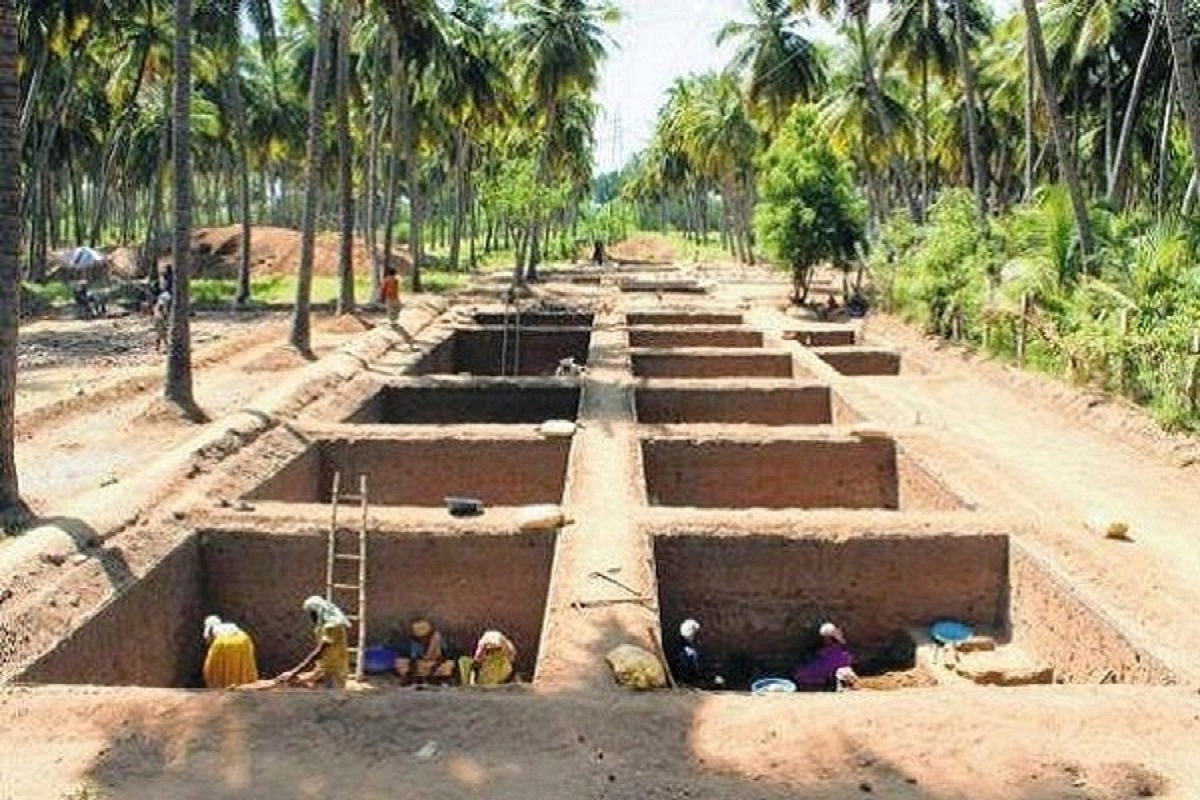Politics
Keeladi: Excavations Place Tamil Nadu In Pan-Indian Context, Refute Separatist Narratives
- While in popular perception Keeladi reinforces Tamil exceptionalism, the dates suggested by the report actually places the site in pan-Indian context.

Excavation at Keeladi site. (Source: Twitter)
The 982-page report on Keeladi excavations submitted to Archaeological Survey of India (ASI) by the controversial archaeologist K Amarnath Ramakrishna, who led the excavations at Keeladi, attests to an urban civilisation in the southern part of India as early as 800 BCE.
The 12-chapter report also deals with the Accelerator Mass Spectrometry (AMS) dating done for some of the samples at the Beta Analytical Lab in Florida, US.
In 2019, a sample taken from the depth of 353 cm, sent for carbon dating to the US, was estimated to be around sixth century BCE.
Historically, this coincides with the second urban wave that swept across India. This would be the archaeological correlates for Sangam literature, and Sangam literature could be the literary correlate of this archaeological discovery.
An important dimension of Keeladi is the discovery of pottery shreds ‘graffiti’ which show Tamil-Brahmi script characters. Names like Athan, Kuviran and Thisa have been identified in them.
These are names that make a regular appearance in excavations identified with what in cultural context corresponds to the Sangam literature.
Earlier, there have been considerable debate regarding the age of the emergence of a civilisation in Tamil provinces, which would correspond to the pan-Indian second urbanisation, and it was suggested that it should be around second or third century BCE.
However, based on Brahmi script presence in Sri Lanka, some of which are considered even pre-Asokan and Tamil-Brahmi presence in Tamil region, archaeologists have argued for an earlier push of this age and correlate this with the Sangam age.
This is not without reason. Names like Athan found in Sangam literature have been attested in archaeological finds.
However, based on the assumptions of influential and no-nonsense scholars like Dr Iravatham Mahadevan, the period of Tamil second urbanisation corresponding to Sangam time was considered second century to third century BCE.
Archaeologists have pointed out that this was inconsistent with pan-Indian cultural and civilisational evolution. Was Tamil Nadu isolated from the overall Indian historical context?
Ironically while in popular perception and politics over Keeladi, it has been projected that Keeladi actually reinforces Tamil exceptionalism, the dates suggested by the report actually places the site in pan-Indian context.
Let us consider one of the names found in Keeladi pottery shreds — Dhisa. The last letter ‘sa’ is for want of a better term — the very Sanskritised ‘sa’ — a letter which the Dravidianists want to exorcise from Tamil language. But right in Keeladi we have the letter.
Also the name appears in many parallel sites — both within India and in Sri Lanka. Often it appears (though alone in Keeladi) with the term ‘Bharata’ — a name associated with not only India but also a coastal community.
It might also be because the coastal community was involved in trade and as they were the traders from the land of Bharata that came to be called ‘Bharathavar’.
That the name Dhisa in its pan-Indian script form obtained at Keeladi also has a pan-Indian name associated with it elsewhere should be an eye-opener to those who use Keeladi to further their artificial north-south divide and exceptionalism narratives.
Sangam literature shows clearly a society that is steeped in vedic values and religion with non-vedic religions like Buddhism and Jainism having a feeble or inferred presence — if we go purely in terms of what the texts reveal.
A late urban civilisation of second century BCE actually suggests in terms of archaeological correlates, a late coming of vedic religion to Tamil homeland or Tamilagam.
But a Sangam age that spans at least from 800 BCE would not only be consistent with a pan-Indian urbanisation wave but also with much earlier presence of the same pan-Indian religious cultural presence.
Here are earlier Swarajya reports on related stories:
Detailed report even as first excavation at Keeladi was happening: here
Ground report from Keeladi: here
Article on Kodumanal Excavations : here
A compilation of Swarajya reports on Keezhadi : here
Introducing ElectionsHQ + 50 Ground Reports Project
The 2024 elections might seem easy to guess, but there are some important questions that shouldn't be missed.
Do freebies still sway voters? Do people prioritise infrastructure when voting? How will Punjab vote?
The answers to these questions provide great insights into where we, as a country, are headed in the years to come.
Swarajya is starting a project with an aim to do 50 solid ground stories and a smart commentary service on WhatsApp, a one-of-a-kind. We'd love your support during this election season.
Click below to contribute.
Latest